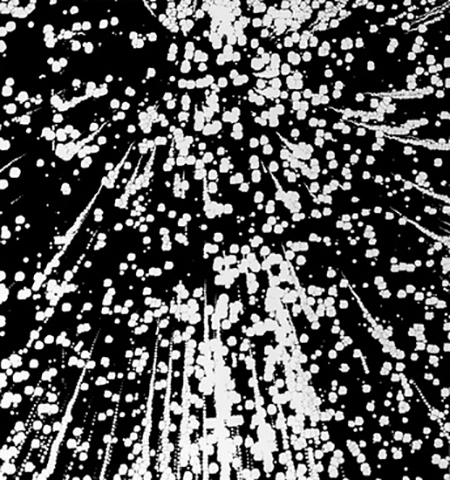
Continuing through January 3, 2015
Scott Short makes copies. And he continues to make them — over and over and over again. In "More and the Same," "the Same" is five new paintings from his career-making oeuvre — images concocted from a heavy sequence of copies — and "More" comes in the form of a relatively surprising departure, "Thank you, Adam West, For Helping To Make Me The Man I Am Today," a series of 48 portraits of revered writers, musicians and thinkers, each camouflaged in Batman headgear.
Fortunate enough to catch the artist prior to the show's opening, I was able to procure some compelling details from his well-honed process: though he originally began using color charts as a source, inspired by Gerhard Richter's color-chart grids (more on Richter later), he has long since then been using standard sheets of single-colored construction paper, with which he makes a machine (Xerox) copy. Then he makes a copy of that copy. And then another. And that process continues for quite a while; sometimes into the hundreds (more intriguing backstory: Short saves and archives each copied sheet). Whatever grain the construction paper may have quickly gets usurped — by 30 generations of copy, says Short, the imagery of the machine takes over. The copying regimen unfolds and evolves until he gets what he wants (I didn't ask what it is that he's looking for, specifically, but it's safe to hazard that it's along the lines of 'he knows it when he sees it,' and is an image that somehow best speaks to the nature of its multi-copied self), and the resulting image is then projected and painted in black and white oils on canvas. The paintings are parenthetically untitled with the color of the construction paper; in this case, a green, a white, a red and two blues.
Reflections on Walter Benjamin's seminal essay "The Work of Art in the Age of Mechanical Reproduction" often crop up around Short's work. The paintings, which, among other things, are simultaneously representations and abstractions, offer a sly rejoinder to at least one angle of Benjamin's thesis — no matter how many degrees of separation an image departs from its original source, that final image stubbornly becomes an original itself. On a more pedestrian level of inquiry, new (but old) questions arise: what should one make of the recurring stylistic patterns? The visual iconography seen in "Untitled (green)," in particular, which can be described as a cross between a vague starburst pattern and light leaking through tree branches (or, more directly/less associatively: dense patches of black broken through by bands and circles of white), has appeared before. Those prior incarnations were also 'greens,' provoking an intriguing scientific/perceptual question: in this methodology, how much does color really matter? If Short is repeating himself, if you will, is that simply a sign that the method is grounded in consistency? Or instead does it point to its limitations, signaling a stylistic inevitability that potentially taints the endeavor with an over-aestheticization?
These are rather forced devil's advocate-based questions; perhaps the better, more succinct one is: how are the works evolving? "Untitled (red)," a spiraling iris-type of image and an outlier here, seems too uniformly composed to be a straight result of the multiple-copy process. It's not clear whether it's a result of a certain mastery (a counterintuitive concept in the art of 'making copies'), or whether it's due to a large amount of editing in post, which is alternately an adaptive decision or just plain wrong, a bit of a sell-out even, as we've come to depend on the pseudo-randomness of the machine's language. But who's to say this spiraling eye didn't result from the usual m.o.?
Converging into this question of the work's evolution is the inclusion of the “More:" the aforementioned portraits that line the back room's walls, ink on paper reincarnations of Richter's infamous "48 Portraits," from '71/72. The portraits — among them of Mahler, Stravinsky, Kafka and Oscar Wilde — are directly appropriated and then altered so that each legendary artist/intellectual is given his own Batman face mask, with the appropriate highlights and shadows to make each a convincing fit (now that's post-production). The series merges heroes of childhood and adulthood (Batman and Richter), and is a tribute to each, though of course with the emphasis on Richter. Though Adam West, for poetic and pop cultural reasons, smirkingly gets all the credit, the credit really goes to Richter, the source of Short's art-making roots. "Thank you, Adam West..." lends levity to the show as a whole, though can still be taken as a side project, a sort of mid-career acknowledgment. The Adam West portraits are funny, but not in the way of the one-liner; despite the absurdist collision, darkness is just as present as the light; sternness somehow pervades. Richter would approve; his work has never been particularly funny either, nor has that ever been much of a problem for him.
